Kepler-22 is a yellow main sequence star located in the constellation Cygnus. With an apparent magnitude of 11.664, the star is invisible to the unaided eye. It lies at an approximate distance of 638 light years from Earth. The Kepler-22 system hosts a planet, designated Kepler-22b, which orbits in the star’s habitable zone. Discovered in 2011, Kepler-22b was the first exoplanet confirmed to be orbiting in the habitable zone of a Sun-like star.
Star type
Kepler-22 is a Sun-like hydrogen-fusing dwarf of the spectral type G5V. It is slightly smaller, less massive and less luminous than the Sun. The star has a mass of 0.97 solar masses and a radius of 0.979 solar radii. With an effective temperature of 5,518 K, it shines with 0.79 solar luminosities. Kepler-22 is a very slow spinner, with a projected rotational velocity of only 0.6 km/s. Its estimated age is about 4 billion years.
Kepler-22b
Kepler-22b was discovered on December 5, 2011 by NASA’s Kepler space telescope. At the time of discovery, it was the first planet with a size comparable to the Earth’s found to be orbiting in its host star’s habitable zone. Kepler-22b was also the first discovered transiting planet orbiting in the habitable zone of a Sun-like star.
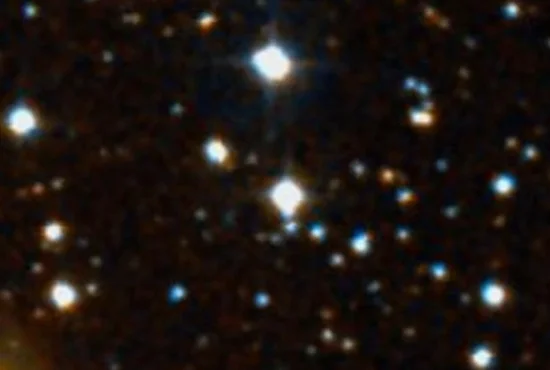
Kepler-22, image: Wikisky
The first transit of Kepler-22b was detected in May 2009, but the confirmation of its existence was not announced until late 2011. The second transit was observed by the Spitzer space telescope in March 2010 and the third one again by the Kepler telescope in December 2010. The confirmation of the planet’s existence came after the fourth transit, which lasted for 7.4 hours and was observed by Spitzer in October 2011. Kepler-22b was one of the 54 habitable planet candidates discovered by the Kepler space telescope and announced in February 2011, before the planet’s existence was officially confirmed. Today, it is listed in the “optimistic sample” of potentially habitable extrasolar planets in the Habitable Exoplanets Catalog. These are planets that are less likely to be rocky in composition or have liquid water on their surfaces.
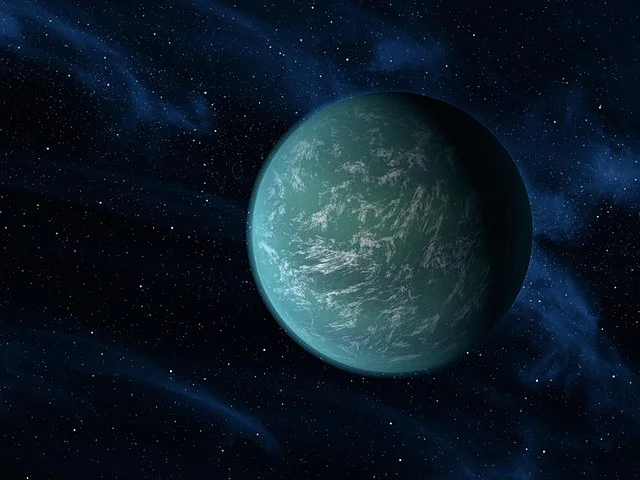
This artist’s conception illustrates Kepler-22b, a planet known to comfortably circle in the habitable zone of a sun-like star. It is the first planet that NASA’s Kepler mission has confirmed to orbit in a star’s habitable zone — the region around a star where liquid water, a requirement for life on Earth, could persist. The planet is 2.4 times the size of Earth, making it the smallest yet found to orbit in the middle of the habitable zone of a star like our sun. Scientists do not yet know if the planet has a predominantly rocky, gaseous or liquid composition. It’s possible that the world would have clouds in its atmosphere, as depicted here in the artist’s interpretation. Image: NASA/Ames/JPL-Caltech, 2011
Kepler-22b has a mass of less than 0.11 Jupiter masses and a radius 2.4 times that of the Earth. With a size more than twice the Earth’s, it must be significantly more massive than our planet, but its exact mass is unknown. The planet orbits Kepler-22 with a period of 289.8623 days at a distance of 0.849 astronomical units. It is about 15% closer to its host star than the Earth is to the Sun. However, since Kepler-22 is about 25% less luminous than the Sun, Kepler-22b likely has a moderate surface temperature, unless it experiences a dramatic greenhouse effect, i.e. unless the radiation from its atmosphere warms the surface to temperatures higher than they would be without the atmosphere.
If the planet does not have an atmosphere and its albedo (the proportion of incident radiation from the star reflected by the planet’s surface) is similar to Earth’s, the planet’s equilibrium temperature is around -11° C (262 K), slightly warmer than Earth’s (-18° C or 255 K). If Kepler-22b does have an atmosphere that provides similar greenhouse heating to the one produced by the Earth’s atmosphere, then its average surface temperature is around 22° C (295 K). However, if the greenhouse heating is similar to that on Venus, then the temperature is considerably higher, around 460° C (733 K). The temperature on the planet’s surface may vary considerably, depending on how elliptical the planet’s orbit is.
A 2013 study looking for exomoons around the planet did not find evidence of any satellites with a mass of over 0.54 Earth masses. The study gave a mass of up to 53 Earth masses and an eccentricity of about 0.13 for the planet. It also demonstrated that the planet has more than a 95% probability of being in the empirical habitable zone (within the recent Venus and early Mars limits), but less than a 5% probability of being in the conservative habitable zone of its host star.
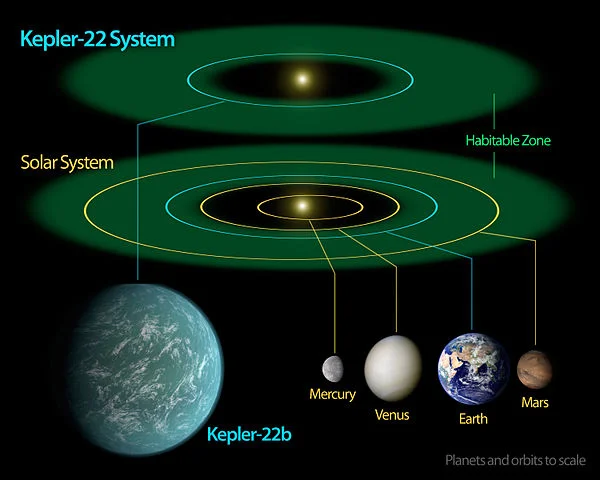
This diagram below compares our own solar system to Kepler-22. The diagram includes the habitable zone where water can exist in liquid form. Kepler-22’s star is a bit smaller than our Sun, so its habitable zone is slightly closer in. The orbit of Kepler-22b around its star takes 289 days and is about 85% as large as Earth’s orbit. Image: NASA/Ames/JPL-Caltech
Kepler-22b is also known by the designation KOI-087.01. KOI stands for Kepler object of interest. Stars with a KOI designation are those observed by the Kepler space telescope that were suspected of having orbiting planets.
Radial velocity measurements indicate that Kepler-22b does not have an Earth-like composition, but the planet’s exact surface composition has not been determined. It is one of the most likely extrasolar candidates for an ocean planet, along with Kepler-62e, Kepler-62f, and TRAPPIST-1.
Facts
Kepler-22b was notably used as the main setting in the television series Raised by Wolves (2020). In the series, the planet is the destination of two androids tasked with raising human children in order to establish a new human civilization after the Earth is destroyed in a great war.
Name
The designation Kepler-22 comes from the name of the space telescope that discovered the exoplanet in the Kepler-22 system. The Kepler space telescope was launched in March 2009 and retired in October 2018. In nine years of operation, it detected 2,662 planets. The space telescope was named the German astronomer and mathematician Johannes Kepler (1571 – 1630), who discovered three laws of planetary motion and was the first to correctly explain the movement of planets.
Location
Kepler-22 is challenging to find because at magnitude 11.664, it can only be seen in 4-inch and larger telescopes. It lies between Fawaris, the star marking the wing of Cygnus, and Eltanin, the brightest of the four stars outlining the head of Draco.
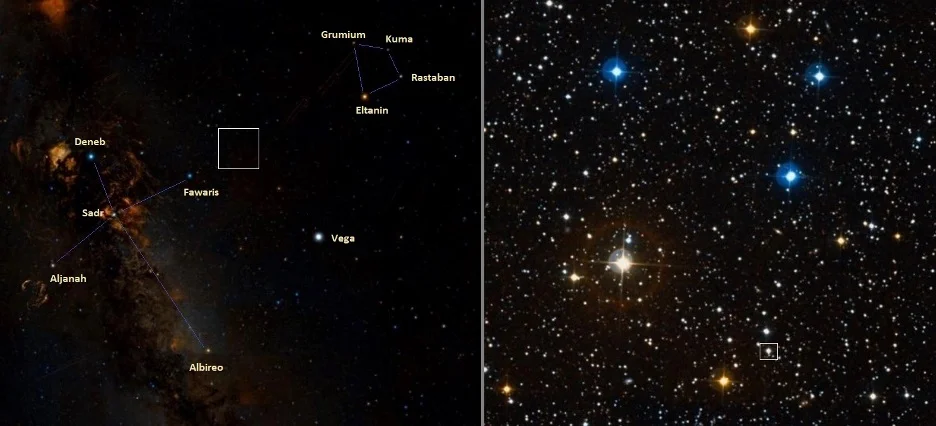
Kepler-22 location, image: Wikisky
Constellation
Kepler-22 is located in the constellation Cygnus, the Swan. Cygnus lies in the northern sky and is the 16th largest of all 88 constellations. It stretches across 804 square degrees. Associated with the myth of Zeus transforming into a swan to seduce the Spartan Queen Leda, Cygnus is one of the 48 Greek constellations, catalogued by Ptolemy of Alexandria in his Almagest in the 2nd century CE.
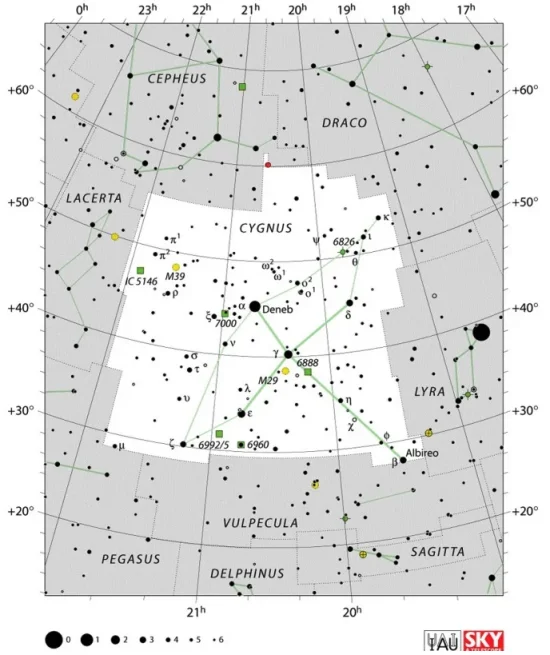
Cygnus constellation map by IAU and Sky&Telescope magazine
Cygnus is one of the most recognizable constellations in the sky because its brightest stars form a conspicuous asterism known as the Northern Cross, visible high overhead during the northern hemisphere summer. The constellation’s brightest star, Deneb, sits at the top of the Cross.
Cygnus is best known for being home to the white supergiant Deneb, the 19th brightest star in the sky and the most distant of first-magnitude stars, and Albireo, a striking contrasting double star which is a popular target for backyard telescopes. Other notable stars in Cygnus include the variable red hypergiant NML Cygni, one of the largest known stars, 61 Cygni (Bessel’s Star), one of the nearest star systems to the Sun, the white supergiant Sadr, the central star of the Northern Cross and of the Gamma Cygni Nebula, the Sun-like stars Kepler-11, which hosts six transiting planets, and Kepler-452, the home of the first known potentially rocky super-Earth orbiting in the habitable zone, and the luminous blue variable P Cygni, one of the most luminous stars in our galaxy.
Cygnus also contains many interesting deep sky objects. These include the open clusters Messier 29, Messier 39 and NGC 6910 (the Rocking Horse Cluster), the spiral galaxy NGC 6946 (the Fireworks Galaxy), and a few well-known nebulae: the Pelican Nebula (IC 5070), the Gamma Cygni Nebula (IC 1318), the Crescent Nebula (NGC 6888), the North America Nebula (NGC 7000), the Veil Nebula (NGC 6960, 6962, 6979, 6992 and 6995) and the Blinking Planetary Nebula (NGC 6826).
The best time of year to see the stars and deep sky objects of Cygnus is during the month of September, when the constellation is prominent in the evening sky. The entire constellation is visible from locations between the latitudes 90° N and 40° S.
The 10 brightest stars in Cygnus are Deneb (Alpha Cyg, mag. 1.25), Sadr (Gamma Cyg, mag. 2.23), Aljanah (Epsilon Cyg, mag. 2.48), Fawaris (Delta Cyg, mag. 2.87), Albireo (Beta Cyg, mag. 2.90), Zeta Cygni (mag. 3.21), Xi Cygni (mag. 3.73), Tau Cygni (mag. 3.65 – 3.75), Iota2 Cygni (mag. 3.77), and Kappa Cygni (mag. 3.814).
Kepler-22
| Spectral class | G5V |
| Apparent magnitude | 11.664 |
| Absolute magnitude | ~5.27 |
| Absolute magnitude (bolometric) | ~4.98 |
| Distance | 638 ± 3 light years (195.7 ± 0.9 parsecs) |
| Parallax | 5.1088 ± 0.0242 mas |
| Radial velocity | -4.06 ± 0.56 km/s |
| Proper motion | RA: −39.717 ± 0.052 mas/yr |
| Dec.: −66.687 ± 0.046 mas/yr | |
| Mass | 0.970 ± 0.060 M☉ |
| Luminosity | 0.79 ± 0.04 L☉ |
| Luminosity (visual) | 0.64 L☉ |
| Luminosity (bolometric) | 0.8 L☉ |
| Radius | 0.979 ± 0.020 R☉ |
| Temperature | 5518 ± 44 K |
| Metallicity | –0.29 ± 0.06 dex |
| Age | 4 billion years |
| Rotational velocity | 0.6 ± 1.0 km/s |
| Constellation | Cygnus |
| Right ascension | 19h 16m 52.1904191915s |
| Declination | +47° 53′ 03. 947532134″ |
| Names and designations | Kepler-22, GSC 03546-02301, KOI-87, 2MASS J19165219+4753040, KIC 10593626, UCAC3 276-148830, Gaia DR2 2127941757262806656 |